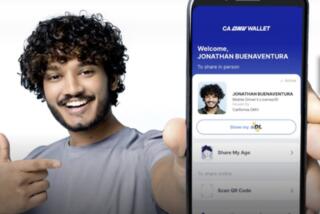California’s hand-held cellphone ban hasn’t reduced crashes, study says
Think your commute is safer now that California requires drivers to use hands-free cellphones?
Maybe not.
A new study from the Highway Loss Data Institute released Friday found that the rate of crashes before and after the landmark law took effect in 2008 has not significantly changed.
The research also found that California’s auto accident trends before and after the cellphone law took effect mirror those of neighboring states such as Arizona and Nevada, which don’t have hand-held phone bans.
“This is making us reexamine some of the assumptions,” said Adrian Lund, president of the Insurance Institute for Highway Safety and its affiliate, the data institute. “We’ve all assumed, because we could measure it pretty well, that maybe cellphone use was a bigger distractor than other things, and I think this data shows us that no, it’s not.”
Lund was quick to point out that the study does not suggest that driving with a cellphone, hand-held or hands-free, is safe. “No one should kid themselves that this isn’t a distraction, because it is,” Lund said.
The report offers ammunition to what some critics have long maintained: That requiring headsets alone would not reduce accidents because drivers could still become distracted even while using a hands-free device.
The findings are sure to heighten debate about the cellphone law, though some traffic safety researchers said the report is far from conclusive.
Steven Bloch, a senior researcher at the Automobile Club of Southern California, said the sample sizes in the study were not large enough to be ultimately conclusive.
“This is interesting, not definitive,” Bloch said.
The insurance institute, which receives claims information from more than 80% of the nation’s auto insurers, looked at data on crashes involving insured cars and concluded that there is no evidence that the hands-free rule is reducing crashes. About 1.7 million claims were used for the study, according to officials with the group.
In California, there were slightly more than eight crashes per 100 vehicles 18 months before the ban on hand-held phones went into effect. Twelve months after the law, there were about 7.5 crashes per 100 vehicles, the study shows.
Authors of the study pointed out that the slight decline in crashes follows a similar trend in neighboring states where there is no such ban. In Arizona, Nevada and Oregon (which recently passed its own ban), there were a little more than seven crashes combined per 100 vehicles 18 months before the ban was passed in California. Twelve months after the California ban, there were a little more than five crashes combined per 100 vehicles in those three states, the study shows.
As the California Legislature passed the law, increasing research showed that the risk doesn’t come from whether one or both hands are on the wheel, but whether a driver’s mind is focused on the road.
Some experts say the largest danger is “cognitive capture,” which means drivers are blind to driving cues because they’re consumed by conversations, particularly emotional ones.
Backers of the law are not convinced by the report.
State Sen. Joe Simitian (D-Palo Alto), who sponsored the bill to ban hand-held cellphones, said the study was “largely a nonevent” because the data sets used were limited. He cited evidence showing a decline in traffic fatalities in the first six months after the law took effect.
In response to the study, the Governors Highway Safety Assn. issued a statement saying the research “raises as many questions as it answers.”
“We need more research and data to determine whether or not hand-held bans should be implemented across the country. GHSA urges states to pass texting bans but hold off on addressing other cell use until some clarity is achieved,” according to a statement.
Russ Rader, a spokesman for the insurance institute, said the study shows that lawmakers need to think more comprehensively about distracted driving.
“We’re not saying cellphone use is less risky than we thought,” Rader said. “What we’re seeing in this study is that the hand-held cellphone laws are not reducing crashes.”






